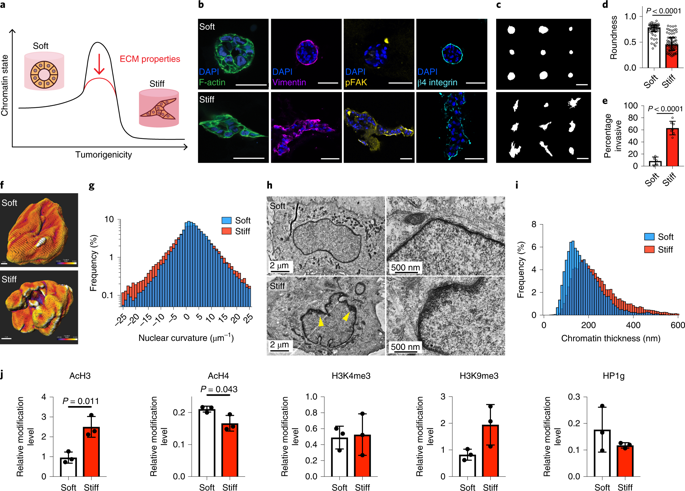当前位置:
X-MOL 学术
›
Nat. Biomed. Eng.
›
论文详情
Our official English website, www.x-mol.net, welcomes your
feedback! (Note: you will need to create a separate account there.)
Matrix stiffness induces a tumorigenic phenotype in mammary epithelium through changes in chromatin accessibility.
Nature Biomedical Engineering ( IF 26.8 ) Pub Date : 2019-07-08 , DOI: 10.1038/s41551-019-0420-5 Ryan S Stowers 1 , Anna Shcherbina 2 , Johnny Israeli 3, 4 , Joshua J Gruber 3, 5 , Julie Chang 6 , Sungmin Nam 1 , Atefeh Rabiee 7 , Mary N Teruel 7 , Michael P Snyder 3 , Anshul Kundaje 3, 8 , Ovijit Chaudhuri 1
Nature Biomedical Engineering ( IF 26.8 ) Pub Date : 2019-07-08 , DOI: 10.1038/s41551-019-0420-5 Ryan S Stowers 1 , Anna Shcherbina 2 , Johnny Israeli 3, 4 , Joshua J Gruber 3, 5 , Julie Chang 6 , Sungmin Nam 1 , Atefeh Rabiee 7 , Mary N Teruel 7 , Michael P Snyder 3 , Anshul Kundaje 3, 8 , Ovijit Chaudhuri 1
Affiliation

|
In breast cancer, the increased stiffness of the extracellular matrix is a key driver of malignancy. Yet little is known about the epigenomic changes that underlie the tumorigenic impact of extracellular matrix mechanics. Here, we show in a three-dimensional culture model of breast cancer that stiff extracellular matrix induces a tumorigenic phenotype through changes in chromatin state. We found that increased stiffness yielded cells with more wrinkled nuclei and with increased lamina-associated chromatin, that cells cultured in stiff matrices displayed more accessible chromatin sites, which exhibited footprints of Sp1 binding, and that this transcription factor acts along with the histone deacetylases 3 and 8 to regulate the induction of stiffness-mediated tumorigenicity. Just as cell culture on soft environments or in them rather than on tissue-culture plastic better recapitulates the acinar morphology observed in mammary epithelium in vivo, mammary epithelial cells cultured on soft microenvironments or in them also more closely replicate the in vivo chromatin state. Our results emphasize the importance of culture conditions for epigenomic studies, and reveal that chromatin state is a critical mediator of mechanotransduction.
中文翻译:

基质硬度通过染色质可及性的变化诱导乳腺上皮的致瘤表型。
在乳腺癌中,细胞外基质硬度的增加是恶性肿瘤的关键驱动因素。然而,人们对细胞外基质力学致瘤影响背后的表观基因组变化知之甚少。在这里,我们在乳腺癌的三维培养模型中表明,坚硬的细胞外基质通过染色质状态的变化诱导致瘤表型。我们发现,硬度增加会产生细胞核更多皱纹和核纤层相关染色质增加的细胞,在坚硬基质中培养的细胞显示出更容易接近的染色质位点,这些位点表现出 Sp1 结合的足迹,并且该转录因子与组蛋白脱乙酰酶一起发挥作用 3 8 调节僵硬介导的致瘤性的诱导。正如在软环境或其中而不是在组织培养塑料上进行细胞培养可以更好地概括体内乳腺上皮中观察到的腺泡形态一样,在软微环境或软微环境中培养的乳腺上皮细胞也更接近地复制体内染色质状态。我们的结果强调了培养条件对于表观基因组研究的重要性,并揭示了染色质状态是力转导的关键介质。
更新日期:2019-07-09
中文翻译:

基质硬度通过染色质可及性的变化诱导乳腺上皮的致瘤表型。
在乳腺癌中,细胞外基质硬度的增加是恶性肿瘤的关键驱动因素。然而,人们对细胞外基质力学致瘤影响背后的表观基因组变化知之甚少。在这里,我们在乳腺癌的三维培养模型中表明,坚硬的细胞外基质通过染色质状态的变化诱导致瘤表型。我们发现,硬度增加会产生细胞核更多皱纹和核纤层相关染色质增加的细胞,在坚硬基质中培养的细胞显示出更容易接近的染色质位点,这些位点表现出 Sp1 结合的足迹,并且该转录因子与组蛋白脱乙酰酶一起发挥作用 3 8 调节僵硬介导的致瘤性的诱导。正如在软环境或其中而不是在组织培养塑料上进行细胞培养可以更好地概括体内乳腺上皮中观察到的腺泡形态一样,在软微环境或软微环境中培养的乳腺上皮细胞也更接近地复制体内染色质状态。我们的结果强调了培养条件对于表观基因组研究的重要性,并揭示了染色质状态是力转导的关键介质。

































 京公网安备 11010802027423号
京公网安备 11010802027423号